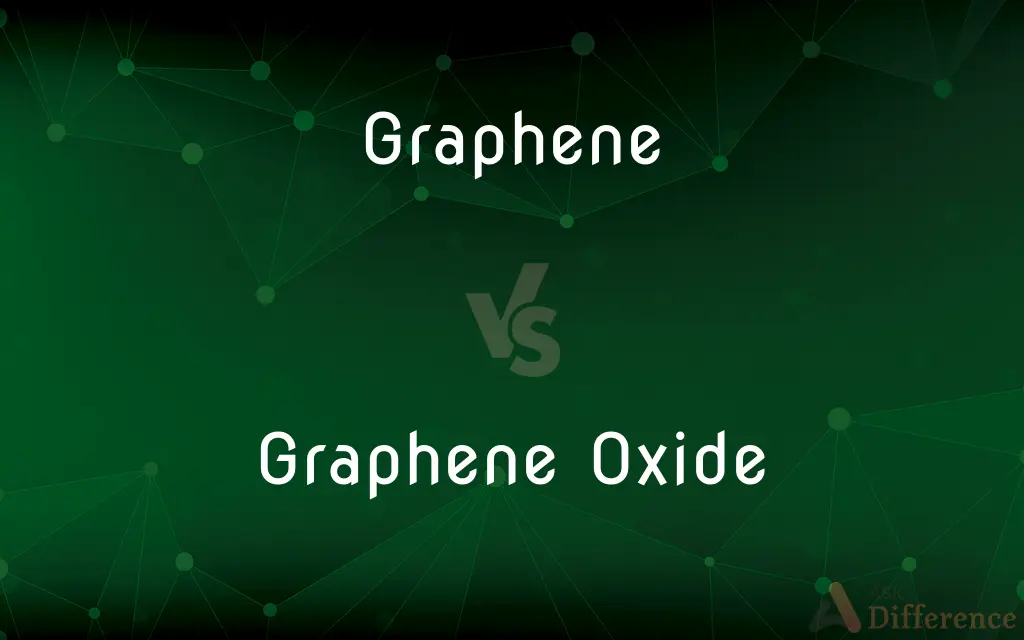Graphene vs. Graphene Oxide — What's the Difference?
By Tayyaba Rehman — Published on January 6, 2024
Graphene is a single layer of carbon atoms in a hexagonal lattice, whereas Graphene Oxide is graphene with various oxygen-containing groups attached.

Difference Between Graphene and Graphene Oxide
Table of Contents
ADVERTISEMENT
Key Differences
Graphene is a single layer of carbon atoms arranged in a two-dimensional hexagonal lattice. It's known for its exceptional strength, electrical conductivity, and thermal properties. Graphene Oxide (GO), on the other hand, is a derivative of graphene that includes oxygen-containing functional groups such as epoxides, hydroxyls, and carboxyls. These groups are typically introduced through chemical oxidation processes.
The presence of these oxygen-containing groups in Graphene Oxide significantly alters its properties compared to pure graphene. While graphene is highly conductive, the introduction of oxygen groups in GO reduces its electrical conductivity. However, GO's solubility in water and other solvents is increased, making it easier to process and manipulate in various applications.
In terms of applications, graphene is often used in electronics, composites, and energy storage devices due to its high conductivity and mechanical strength. Graphene Oxide, with its functional groups, is more versatile in chemical reactions and is used in areas such as drug delivery, biosensors, and as a precursor for reduced graphene oxide (rGO), which partially restores the electrical conductivity.
The synthesis of graphene often involves methods like chemical vapor deposition or micromechanical exfoliation, focusing on maintaining its pure carbon structure. Graphene Oxide is typically synthesized by oxidizing graphite, a process that introduces various oxygen groups to the graphene layers.
In summary, while graphene and Graphene Oxide share a similar base structure of carbon atoms in a hexagonal lattice, their properties and applications differ significantly due to the presence of oxygen-containing functional groups in Graphene Oxide.
ADVERTISEMENT
Comparison Chart
Structure
Single layer of carbon atoms in hexagonal lattice
Graphene with oxygen-containing groups
Electrical Conductivity
High conductivity
Reduced conductivity due to oxygen groups
Solubility
Insoluble in water
Soluble in water and other solvents
Applications
Electronics, composites, energy storage
Drug delivery, biosensors, rGO production
Synthesis Method
Chemical vapor deposition, exfoliation
Oxidation of graphite
Compare with Definitions
Graphene
Graphene is a single layer of carbon atoms in a hexagonal lattice.
Graphene's strength and conductivity make it ideal for use in advanced electronics.
Graphene Oxide
Graphene Oxide is graphene with oxygen functional groups.
Graphene Oxide's solubility in water broadens its application in biotechnology.
Graphene
Graphene is a two-dimensional material with a thickness of one atom.
Graphene is remarkably thin yet stronger than steel.
Graphene Oxide
Graphene Oxide is synthesized through the oxidation of graphite.
Graphene Oxide is produced in laboratories by oxidizing graphite powder.
Graphene
Graphene is known for its exceptional electrical and thermal properties.
Graphene is used in batteries due to its high electrical conductivity.
Graphene Oxide
Graphene Oxide is used as a precursor for producing reduced graphene oxide.
Reduced Graphene Oxide is obtained by chemically reducing Graphene Oxide.
Graphene
Graphene is one of the strongest materials known.
Graphene's tensile strength is used to enhance composite materials.
Graphene Oxide
Graphene Oxide is versatile in chemical applications due to its functional groups.
Graphene Oxide is used in drug delivery systems for its chemical reactivity.
Graphene
Graphene is insoluble in water.
Due to its hydrophobic nature, graphene does not dissolve in water.
Graphene Oxide
Graphene Oxide has reduced electrical conductivity compared to graphene.
The oxygen groups in Graphene Oxide decrease its conductivity.
Graphene
A monolayer of carbon atoms having a hexagonal lattice structure and constituting a basic structural element of graphite, fullerenes, and carbon nanotubes.
Graphene
(organic chemistry) Any polycyclic aromatic hydrocarbon having the structure of part of a layer of graphite.
Graphene
(inorganic chemistry) An arbitrarily large-scale, one-atom-thick layer of graphite, an allotrope of carbon, that has remarkable electric characteristics.
Common Curiosities
Is graphene conductive?
Yes, graphene is highly conductive electrically.
How is graphene synthesized?
It's synthesized through methods like chemical vapor deposition or micromechanical exfoliation.
What makes Graphene Oxide different from graphene?
The presence of oxygen-containing groups in Graphene Oxide alters its properties.
What are the applications of graphene?
It's used in electronics, composites, and energy storage devices.
What is Graphene Oxide?
Graphene Oxide is a derivative of graphene with added oxygen-containing groups.
Are graphene and Graphene Oxide the same?
No, they differ in their chemical structure and properties.
What are Graphene Oxide's applications?
It's used in drug delivery, biosensors, and as a precursor for reduced graphene oxide.
What is graphene?
Graphene is a single layer of carbon atoms arranged in a hexagonal lattice.
How is Graphene Oxide synthesized?
By oxidizing graphite in a controlled chemical process.
Can Graphene Oxide be used in biotechnology?
Yes, its solubility and functional groups make it suitable for biotech applications.
Can Graphene Oxide conduct electricity?
Its conductivity is reduced compared to graphene due to oxygen groups.
Is Graphene Oxide soluble in water?
Yes, it's more soluble in water compared to graphene.
What is reduced graphene oxide?
It's a form of graphene oxide that has been chemically reduced to increase its conductivity.
Why is graphene considered a revolutionary material?
Its combination of strength, conductivity, and thinness opens up many advanced technological applications.
Is graphene stronger than steel?
Yes, graphene is much stronger than steel despite being extremely thin.
Share Your Discovery

Previous Comparison
Tracheids vs. Vessels
Next Comparison
Rational Choice Theory vs. Deterrence TheoryAuthor Spotlight
Written by
Tayyaba RehmanTayyaba Rehman is a distinguished writer, currently serving as a primary contributor to askdifference.com. As a researcher in semantics and etymology, Tayyaba's passion for the complexity of languages and their distinctions has found a perfect home on the platform. Tayyaba delves into the intricacies of language, distinguishing between commonly confused words and phrases, thereby providing clarity for readers worldwide.
















































